Finance and Funding in Travel and Tourism Sector - Coursework Report
VerifiedAdded on 2023/02/03
|15
|3760
|99
Report
AI Summary
This report provides a comprehensive analysis of finance and funding within the travel and tourism sector, focusing on Carnival Corporation Plc. It delves into the importance of cost and volume in financial management, analyzing various cost types, allocation methods, and cost-volume-profit analysis, including break-even analysis and economies of scale. The report also examines different pricing methods used in the sector, such as cost-led, market-led, cost-plus, and contribution pricing, along with their implications. Furthermore, it explores factors influencing profits, including seasonal variations, political and economic environments, social factors, current trends, and bad debts. The report extends its analysis to include the interpretation of financial accounts for Dalata Hotel Group Plc, assessing profitability and liquidity ratios. Finally, it discusses sources of funding and the distribution of funds for the development of capital projects in both public and non-public tourism development, offering a complete overview of the financial landscape of the industry.
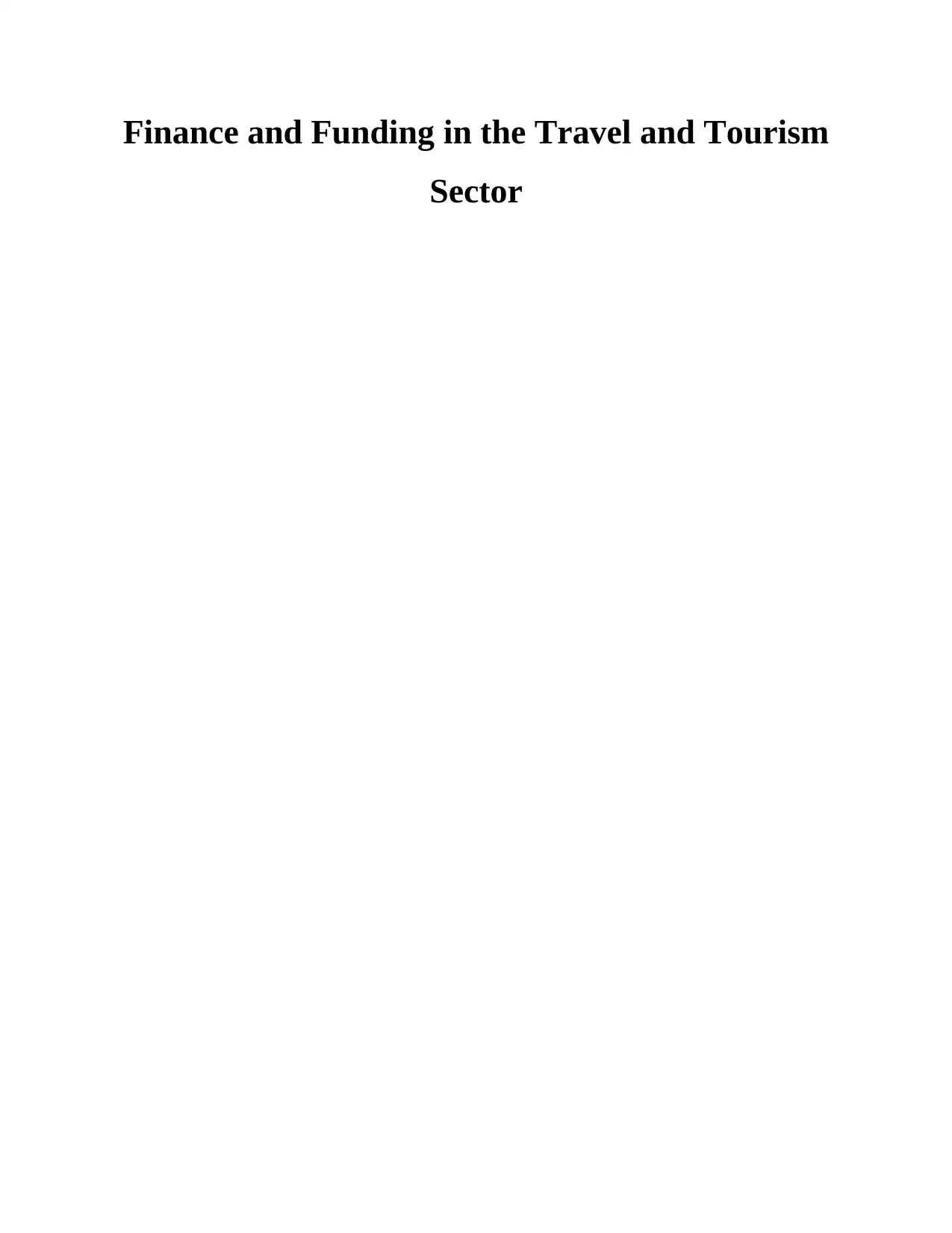
Finance and Funding in the Travel and Tourism
Sector
Sector
Paraphrase This Document
Need a fresh take? Get an instant paraphrase of this document with our AI Paraphraser
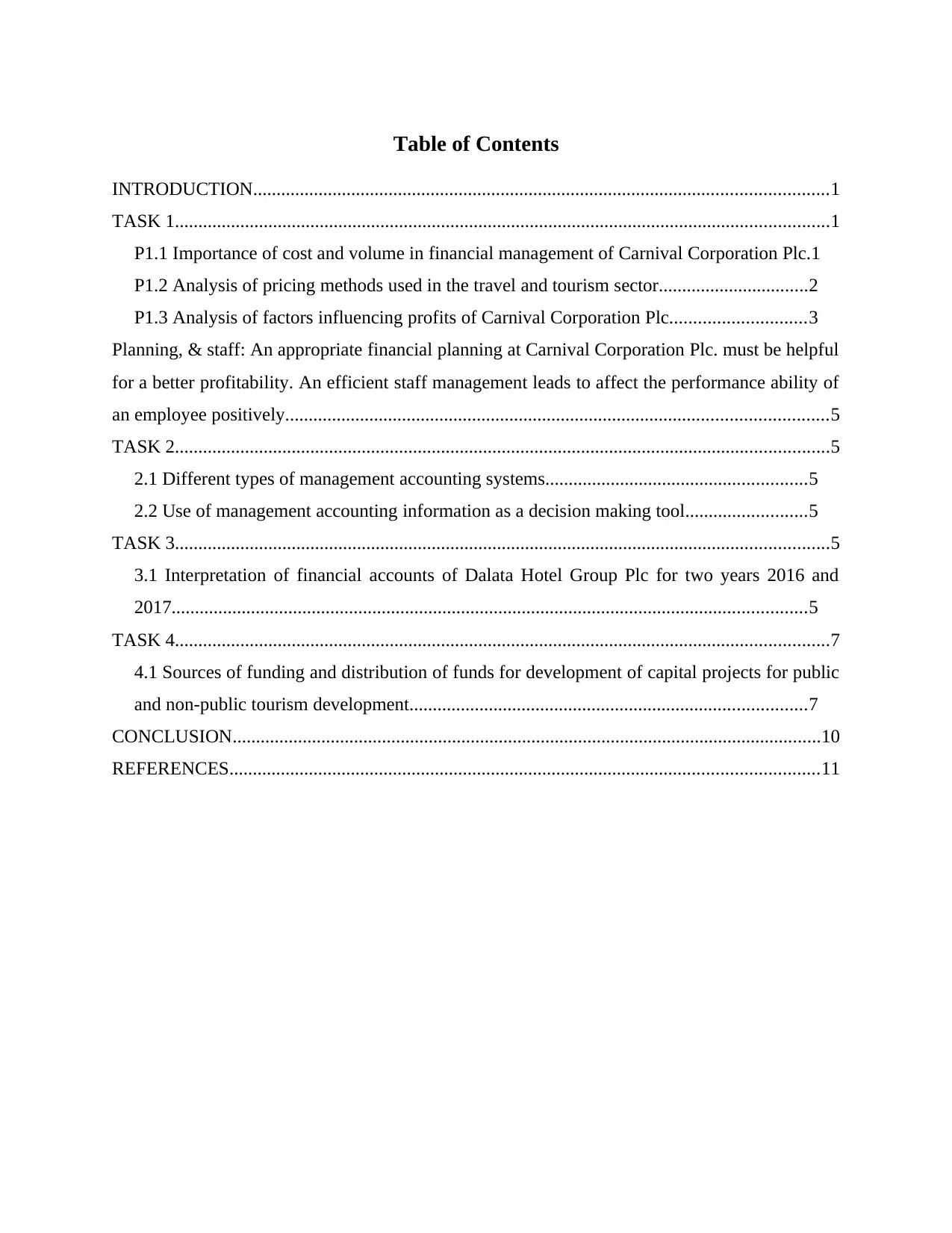
Table of Contents
INTRODUCTION...........................................................................................................................1
TASK 1............................................................................................................................................1
P1.1 Importance of cost and volume in financial management of Carnival Corporation Plc.1
P1.2 Analysis of pricing methods used in the travel and tourism sector................................2
P1.3 Analysis of factors influencing profits of Carnival Corporation Plc.............................3
Planning, & staff: An appropriate financial planning at Carnival Corporation Plc. must be helpful
for a better profitability. An efficient staff management leads to affect the performance ability of
an employee positively....................................................................................................................5
TASK 2............................................................................................................................................5
2.1 Different types of management accounting systems........................................................5
2.2 Use of management accounting information as a decision making tool..........................5
TASK 3............................................................................................................................................5
3.1 Interpretation of financial accounts of Dalata Hotel Group Plc for two years 2016 and
2017........................................................................................................................................5
TASK 4............................................................................................................................................7
4.1 Sources of funding and distribution of funds for development of capital projects for public
and non-public tourism development.....................................................................................7
CONCLUSION..............................................................................................................................10
REFERENCES..............................................................................................................................11
INTRODUCTION...........................................................................................................................1
TASK 1............................................................................................................................................1
P1.1 Importance of cost and volume in financial management of Carnival Corporation Plc.1
P1.2 Analysis of pricing methods used in the travel and tourism sector................................2
P1.3 Analysis of factors influencing profits of Carnival Corporation Plc.............................3
Planning, & staff: An appropriate financial planning at Carnival Corporation Plc. must be helpful
for a better profitability. An efficient staff management leads to affect the performance ability of
an employee positively....................................................................................................................5
TASK 2............................................................................................................................................5
2.1 Different types of management accounting systems........................................................5
2.2 Use of management accounting information as a decision making tool..........................5
TASK 3............................................................................................................................................5
3.1 Interpretation of financial accounts of Dalata Hotel Group Plc for two years 2016 and
2017........................................................................................................................................5
TASK 4............................................................................................................................................7
4.1 Sources of funding and distribution of funds for development of capital projects for public
and non-public tourism development.....................................................................................7
CONCLUSION..............................................................................................................................10
REFERENCES..............................................................................................................................11
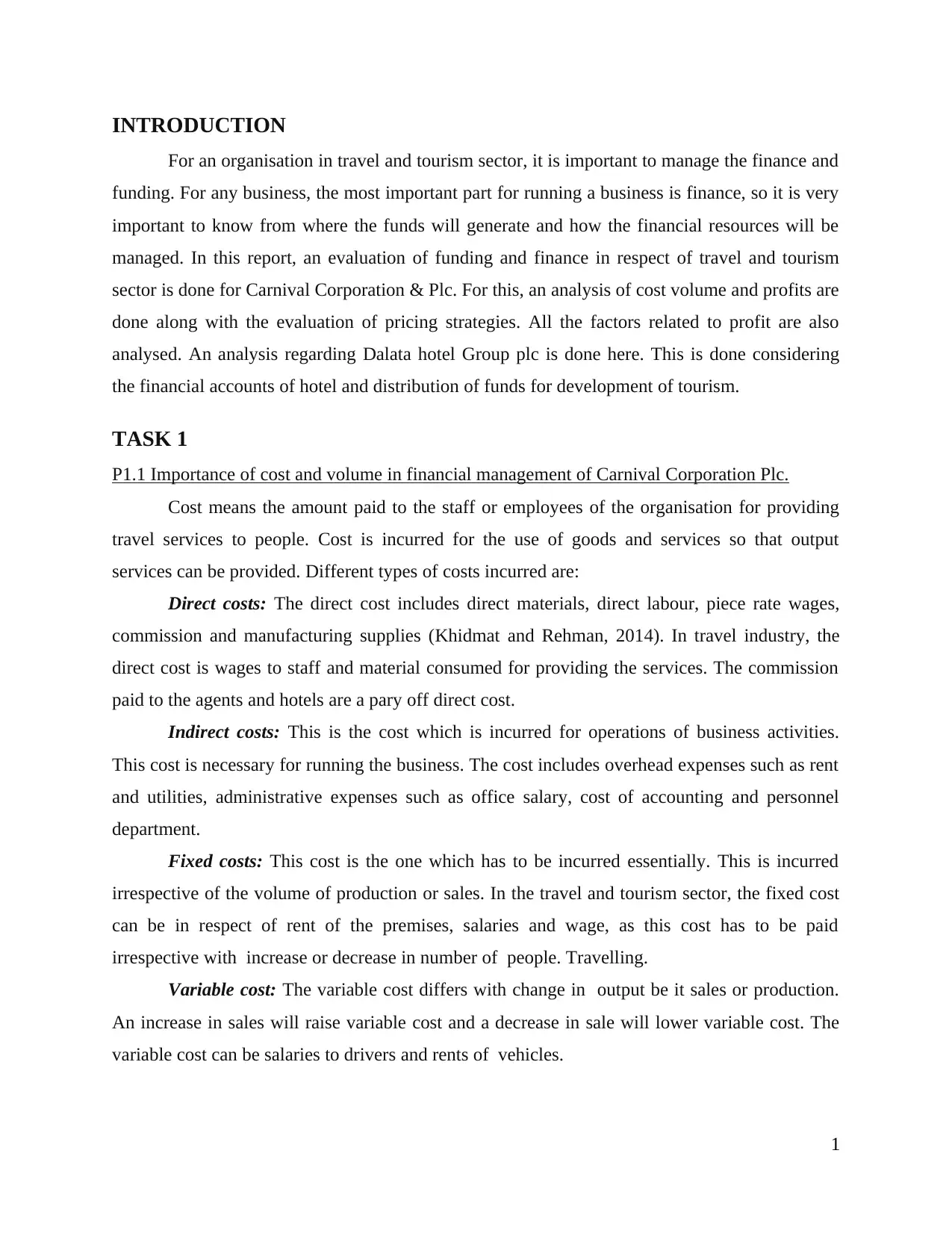
INTRODUCTION
For an organisation in travel and tourism sector, it is important to manage the finance and
funding. For any business, the most important part for running a business is finance, so it is very
important to know from where the funds will generate and how the financial resources will be
managed. In this report, an evaluation of funding and finance in respect of travel and tourism
sector is done for Carnival Corporation & Plc. For this, an analysis of cost volume and profits are
done along with the evaluation of pricing strategies. All the factors related to profit are also
analysed. An analysis regarding Dalata hotel Group plc is done here. This is done considering
the financial accounts of hotel and distribution of funds for development of tourism.
TASK 1
P1.1 Importance of cost and volume in financial management of Carnival Corporation Plc.
Cost means the amount paid to the staff or employees of the organisation for providing
travel services to people. Cost is incurred for the use of goods and services so that output
services can be provided. Different types of costs incurred are:
Direct costs: The direct cost includes direct materials, direct labour, piece rate wages,
commission and manufacturing supplies (Khidmat and Rehman, 2014). In travel industry, the
direct cost is wages to staff and material consumed for providing the services. The commission
paid to the agents and hotels are a pary off direct cost.
Indirect costs: This is the cost which is incurred for operations of business activities.
This cost is necessary for running the business. The cost includes overhead expenses such as rent
and utilities, administrative expenses such as office salary, cost of accounting and personnel
department.
Fixed costs: This cost is the one which has to be incurred essentially. This is incurred
irrespective of the volume of production or sales. In the travel and tourism sector, the fixed cost
can be in respect of rent of the premises, salaries and wage, as this cost has to be paid
irrespective with increase or decrease in number of people. Travelling.
Variable cost: The variable cost differs with change in output be it sales or production.
An increase in sales will raise variable cost and a decrease in sale will lower variable cost. The
variable cost can be salaries to drivers and rents of vehicles.
1
For an organisation in travel and tourism sector, it is important to manage the finance and
funding. For any business, the most important part for running a business is finance, so it is very
important to know from where the funds will generate and how the financial resources will be
managed. In this report, an evaluation of funding and finance in respect of travel and tourism
sector is done for Carnival Corporation & Plc. For this, an analysis of cost volume and profits are
done along with the evaluation of pricing strategies. All the factors related to profit are also
analysed. An analysis regarding Dalata hotel Group plc is done here. This is done considering
the financial accounts of hotel and distribution of funds for development of tourism.
TASK 1
P1.1 Importance of cost and volume in financial management of Carnival Corporation Plc.
Cost means the amount paid to the staff or employees of the organisation for providing
travel services to people. Cost is incurred for the use of goods and services so that output
services can be provided. Different types of costs incurred are:
Direct costs: The direct cost includes direct materials, direct labour, piece rate wages,
commission and manufacturing supplies (Khidmat and Rehman, 2014). In travel industry, the
direct cost is wages to staff and material consumed for providing the services. The commission
paid to the agents and hotels are a pary off direct cost.
Indirect costs: This is the cost which is incurred for operations of business activities.
This cost is necessary for running the business. The cost includes overhead expenses such as rent
and utilities, administrative expenses such as office salary, cost of accounting and personnel
department.
Fixed costs: This cost is the one which has to be incurred essentially. This is incurred
irrespective of the volume of production or sales. In the travel and tourism sector, the fixed cost
can be in respect of rent of the premises, salaries and wage, as this cost has to be paid
irrespective with increase or decrease in number of people. Travelling.
Variable cost: The variable cost differs with change in output be it sales or production.
An increase in sales will raise variable cost and a decrease in sale will lower variable cost. The
variable cost can be salaries to drivers and rents of vehicles.
1
⊘ This is a preview!⊘
Do you want full access?
Subscribe today to unlock all pages.

Trusted by 1+ million students worldwide

Allocation: A proper allocation of cost is very necessary for a business. Allocation means
to identify, aggregate and assign cost. The cost allocation is to spread the cost as per departments
or inventories.
Apportionment: Apportionment means to divide the cost means to share a group
expenditure among individual streams of funding. This method is used to spread general cost of
business that is salary, general overhead and operational cost. All these costs are apportioned to
individual departments to cover the cost.
Cost volume profit analysis: This analysis is done to determine the changes in cost and
volume of company. This shows the effect of change in cost and profits on Carnival Corporation
& Plc.the extra cost incurred on operations of the organisation are compensated by earning
sufficient profits. Basically it is concerned with the volume of sale and cost of product having an
effect on profits of company.
Break-even analysis: With the help of this analysis, an organisation can determine the
sales or revenue that shall be earned to cover cost incurred in business. Break-even point is
where the cost and revenue of firm is equal (Petria, Capraru,and Ihnatov, 2015.). The business is
in no profit and no loss situation. The analysis is done to know the exact amount that shall be
earned to cover fixed and variable cost of the business. This also states that weather there is a
requirement to increase the sales revenue to cover the cost of business.
Economies of scale: This means to achieve a position where production of units of a
product is done at a large scale with a lesser input cost (Weilburg and et.al., 2017). This will be
beneficial for Carnival Corporation Plc. for achieving growth by increase in the production with
a chance to incur less cost on production.
Diseconomies of scale: This is a situation where additional cost is incurred for increasing
the production or going big. This is a cost disadvantage that an organisation has incurred due to
the large size of the organisation. Carnival Corporation Plc shall avoid this situation. spending a
large amount without any increase in profits is not good for the organisation.
P1.2 Analysis of pricing methods used in the travel and tourism sector
The different types of pricing methods that an organisation shall evaluate and analyse
are:
Cost-led: This is pricing technique in which an organisation determines the actual cost
incurred on the production of its units. These will help in setting up the profit margin and
2
to identify, aggregate and assign cost. The cost allocation is to spread the cost as per departments
or inventories.
Apportionment: Apportionment means to divide the cost means to share a group
expenditure among individual streams of funding. This method is used to spread general cost of
business that is salary, general overhead and operational cost. All these costs are apportioned to
individual departments to cover the cost.
Cost volume profit analysis: This analysis is done to determine the changes in cost and
volume of company. This shows the effect of change in cost and profits on Carnival Corporation
& Plc.the extra cost incurred on operations of the organisation are compensated by earning
sufficient profits. Basically it is concerned with the volume of sale and cost of product having an
effect on profits of company.
Break-even analysis: With the help of this analysis, an organisation can determine the
sales or revenue that shall be earned to cover cost incurred in business. Break-even point is
where the cost and revenue of firm is equal (Petria, Capraru,and Ihnatov, 2015.). The business is
in no profit and no loss situation. The analysis is done to know the exact amount that shall be
earned to cover fixed and variable cost of the business. This also states that weather there is a
requirement to increase the sales revenue to cover the cost of business.
Economies of scale: This means to achieve a position where production of units of a
product is done at a large scale with a lesser input cost (Weilburg and et.al., 2017). This will be
beneficial for Carnival Corporation Plc. for achieving growth by increase in the production with
a chance to incur less cost on production.
Diseconomies of scale: This is a situation where additional cost is incurred for increasing
the production or going big. This is a cost disadvantage that an organisation has incurred due to
the large size of the organisation. Carnival Corporation Plc shall avoid this situation. spending a
large amount without any increase in profits is not good for the organisation.
P1.2 Analysis of pricing methods used in the travel and tourism sector
The different types of pricing methods that an organisation shall evaluate and analyse
are:
Cost-led: This is pricing technique in which an organisation determines the actual cost
incurred on the production of its units. These will help in setting up the profit margin and
2
Paraphrase This Document
Need a fresh take? Get an instant paraphrase of this document with our AI Paraphraser
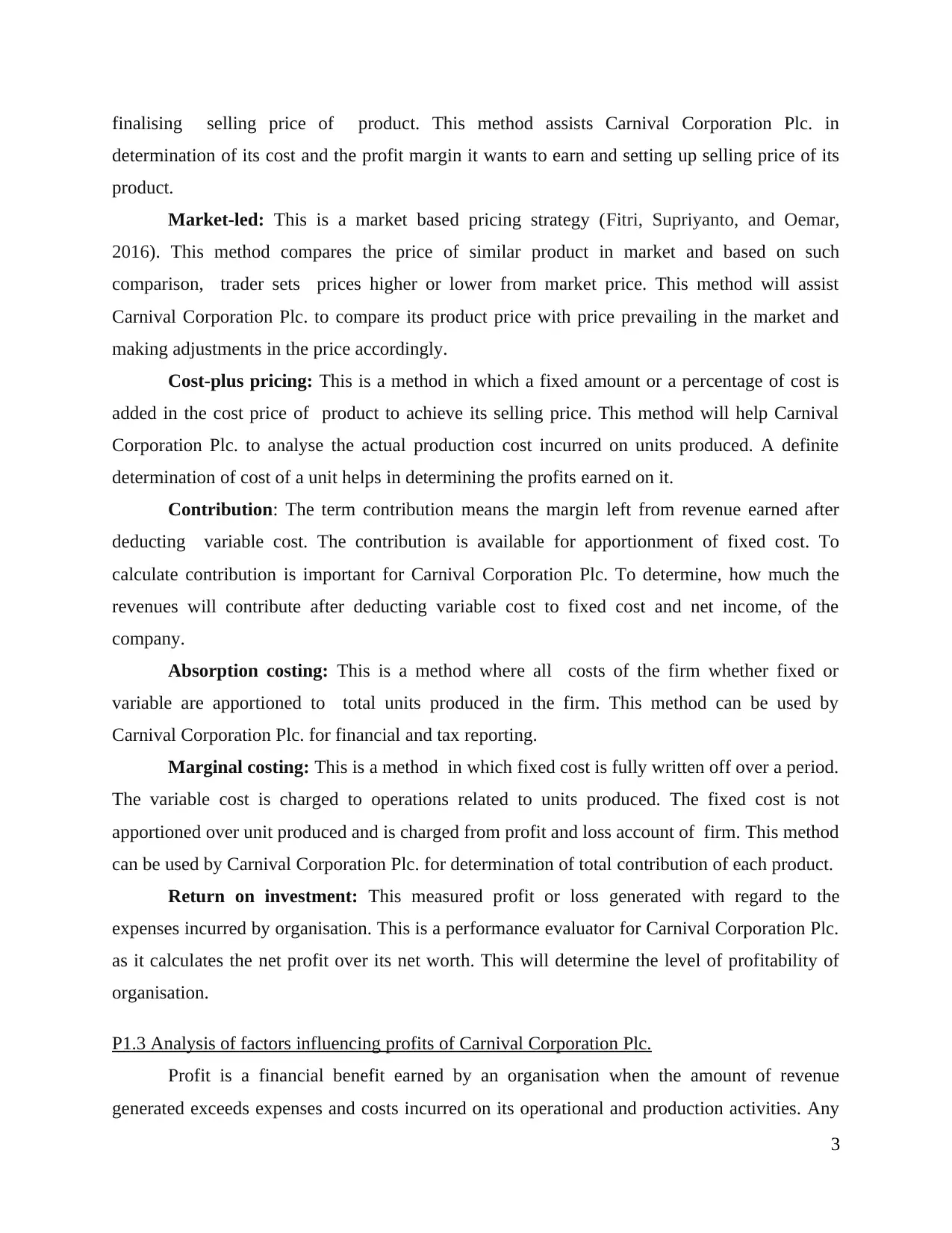
finalising selling price of product. This method assists Carnival Corporation Plc. in
determination of its cost and the profit margin it wants to earn and setting up selling price of its
product.
Market-led: This is a market based pricing strategy (Fitri, Supriyanto, and Oemar,
2016). This method compares the price of similar product in market and based on such
comparison, trader sets prices higher or lower from market price. This method will assist
Carnival Corporation Plc. to compare its product price with price prevailing in the market and
making adjustments in the price accordingly.
Cost-plus pricing: This is a method in which a fixed amount or a percentage of cost is
added in the cost price of product to achieve its selling price. This method will help Carnival
Corporation Plc. to analyse the actual production cost incurred on units produced. A definite
determination of cost of a unit helps in determining the profits earned on it.
Contribution: The term contribution means the margin left from revenue earned after
deducting variable cost. The contribution is available for apportionment of fixed cost. To
calculate contribution is important for Carnival Corporation Plc. To determine, how much the
revenues will contribute after deducting variable cost to fixed cost and net income, of the
company.
Absorption costing: This is a method where all costs of the firm whether fixed or
variable are apportioned to total units produced in the firm. This method can be used by
Carnival Corporation Plc. for financial and tax reporting.
Marginal costing: This is a method in which fixed cost is fully written off over a period.
The variable cost is charged to operations related to units produced. The fixed cost is not
apportioned over unit produced and is charged from profit and loss account of firm. This method
can be used by Carnival Corporation Plc. for determination of total contribution of each product.
Return on investment: This measured profit or loss generated with regard to the
expenses incurred by organisation. This is a performance evaluator for Carnival Corporation Plc.
as it calculates the net profit over its net worth. This will determine the level of profitability of
organisation.
P1.3 Analysis of factors influencing profits of Carnival Corporation Plc.
Profit is a financial benefit earned by an organisation when the amount of revenue
generated exceeds expenses and costs incurred on its operational and production activities. Any
3
determination of its cost and the profit margin it wants to earn and setting up selling price of its
product.
Market-led: This is a market based pricing strategy (Fitri, Supriyanto, and Oemar,
2016). This method compares the price of similar product in market and based on such
comparison, trader sets prices higher or lower from market price. This method will assist
Carnival Corporation Plc. to compare its product price with price prevailing in the market and
making adjustments in the price accordingly.
Cost-plus pricing: This is a method in which a fixed amount or a percentage of cost is
added in the cost price of product to achieve its selling price. This method will help Carnival
Corporation Plc. to analyse the actual production cost incurred on units produced. A definite
determination of cost of a unit helps in determining the profits earned on it.
Contribution: The term contribution means the margin left from revenue earned after
deducting variable cost. The contribution is available for apportionment of fixed cost. To
calculate contribution is important for Carnival Corporation Plc. To determine, how much the
revenues will contribute after deducting variable cost to fixed cost and net income, of the
company.
Absorption costing: This is a method where all costs of the firm whether fixed or
variable are apportioned to total units produced in the firm. This method can be used by
Carnival Corporation Plc. for financial and tax reporting.
Marginal costing: This is a method in which fixed cost is fully written off over a period.
The variable cost is charged to operations related to units produced. The fixed cost is not
apportioned over unit produced and is charged from profit and loss account of firm. This method
can be used by Carnival Corporation Plc. for determination of total contribution of each product.
Return on investment: This measured profit or loss generated with regard to the
expenses incurred by organisation. This is a performance evaluator for Carnival Corporation Plc.
as it calculates the net profit over its net worth. This will determine the level of profitability of
organisation.
P1.3 Analysis of factors influencing profits of Carnival Corporation Plc.
Profit is a financial benefit earned by an organisation when the amount of revenue
generated exceeds expenses and costs incurred on its operational and production activities. Any
3
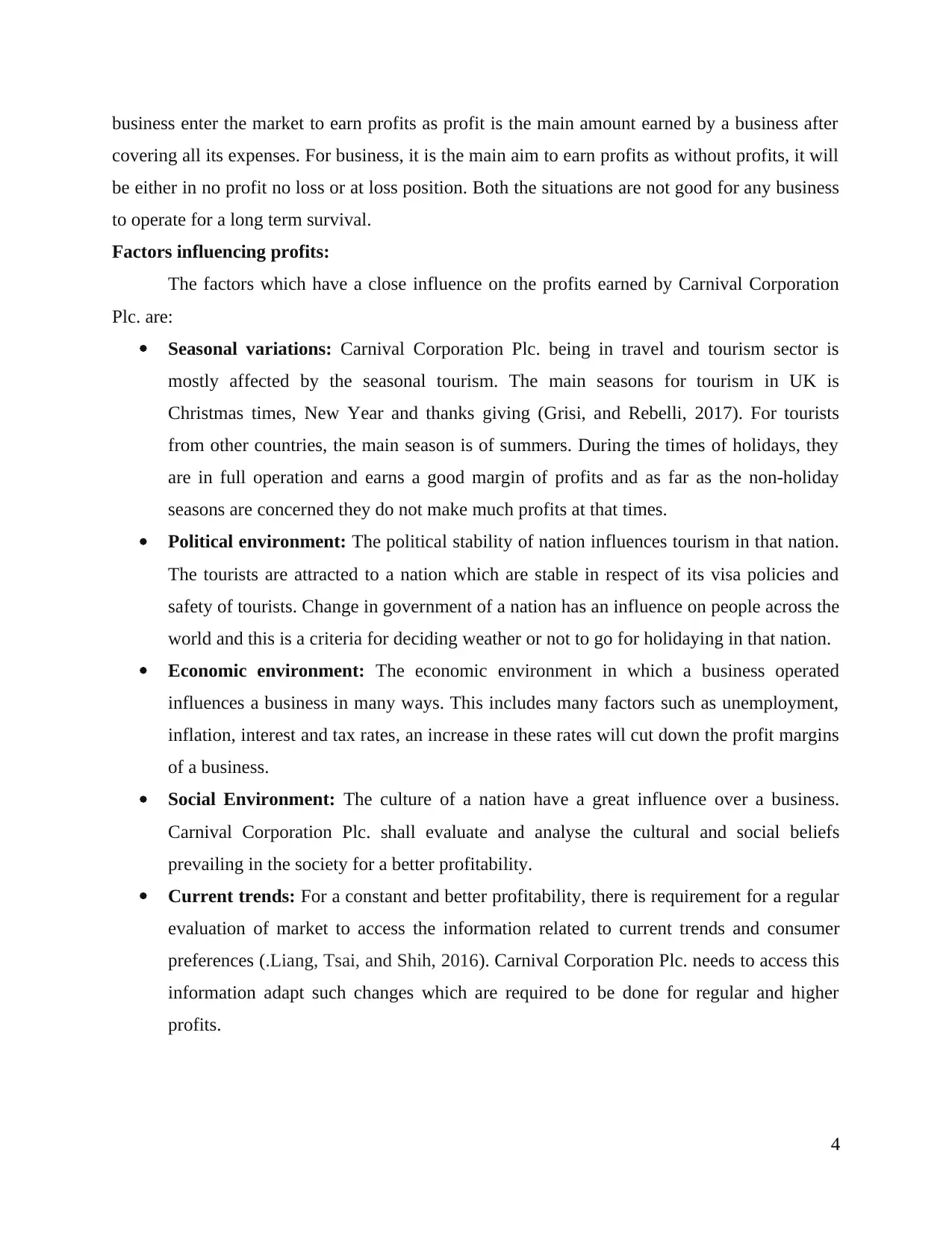
business enter the market to earn profits as profit is the main amount earned by a business after
covering all its expenses. For business, it is the main aim to earn profits as without profits, it will
be either in no profit no loss or at loss position. Both the situations are not good for any business
to operate for a long term survival.
Factors influencing profits:
The factors which have a close influence on the profits earned by Carnival Corporation
Plc. are:
Seasonal variations: Carnival Corporation Plc. being in travel and tourism sector is
mostly affected by the seasonal tourism. The main seasons for tourism in UK is
Christmas times, New Year and thanks giving (Grisi, and Rebelli, 2017). For tourists
from other countries, the main season is of summers. During the times of holidays, they
are in full operation and earns a good margin of profits and as far as the non-holiday
seasons are concerned they do not make much profits at that times.
Political environment: The political stability of nation influences tourism in that nation.
The tourists are attracted to a nation which are stable in respect of its visa policies and
safety of tourists. Change in government of a nation has an influence on people across the
world and this is a criteria for deciding weather or not to go for holidaying in that nation.
Economic environment: The economic environment in which a business operated
influences a business in many ways. This includes many factors such as unemployment,
inflation, interest and tax rates, an increase in these rates will cut down the profit margins
of a business.
Social Environment: The culture of a nation have a great influence over a business.
Carnival Corporation Plc. shall evaluate and analyse the cultural and social beliefs
prevailing in the society for a better profitability.
Current trends: For a constant and better profitability, there is requirement for a regular
evaluation of market to access the information related to current trends and consumer
preferences (.Liang, Tsai, and Shih, 2016). Carnival Corporation Plc. needs to access this
information adapt such changes which are required to be done for regular and higher
profits.
4
covering all its expenses. For business, it is the main aim to earn profits as without profits, it will
be either in no profit no loss or at loss position. Both the situations are not good for any business
to operate for a long term survival.
Factors influencing profits:
The factors which have a close influence on the profits earned by Carnival Corporation
Plc. are:
Seasonal variations: Carnival Corporation Plc. being in travel and tourism sector is
mostly affected by the seasonal tourism. The main seasons for tourism in UK is
Christmas times, New Year and thanks giving (Grisi, and Rebelli, 2017). For tourists
from other countries, the main season is of summers. During the times of holidays, they
are in full operation and earns a good margin of profits and as far as the non-holiday
seasons are concerned they do not make much profits at that times.
Political environment: The political stability of nation influences tourism in that nation.
The tourists are attracted to a nation which are stable in respect of its visa policies and
safety of tourists. Change in government of a nation has an influence on people across the
world and this is a criteria for deciding weather or not to go for holidaying in that nation.
Economic environment: The economic environment in which a business operated
influences a business in many ways. This includes many factors such as unemployment,
inflation, interest and tax rates, an increase in these rates will cut down the profit margins
of a business.
Social Environment: The culture of a nation have a great influence over a business.
Carnival Corporation Plc. shall evaluate and analyse the cultural and social beliefs
prevailing in the society for a better profitability.
Current trends: For a constant and better profitability, there is requirement for a regular
evaluation of market to access the information related to current trends and consumer
preferences (.Liang, Tsai, and Shih, 2016). Carnival Corporation Plc. needs to access this
information adapt such changes which are required to be done for regular and higher
profits.
4
⊘ This is a preview!⊘
Do you want full access?
Subscribe today to unlock all pages.

Trusted by 1+ million students worldwide
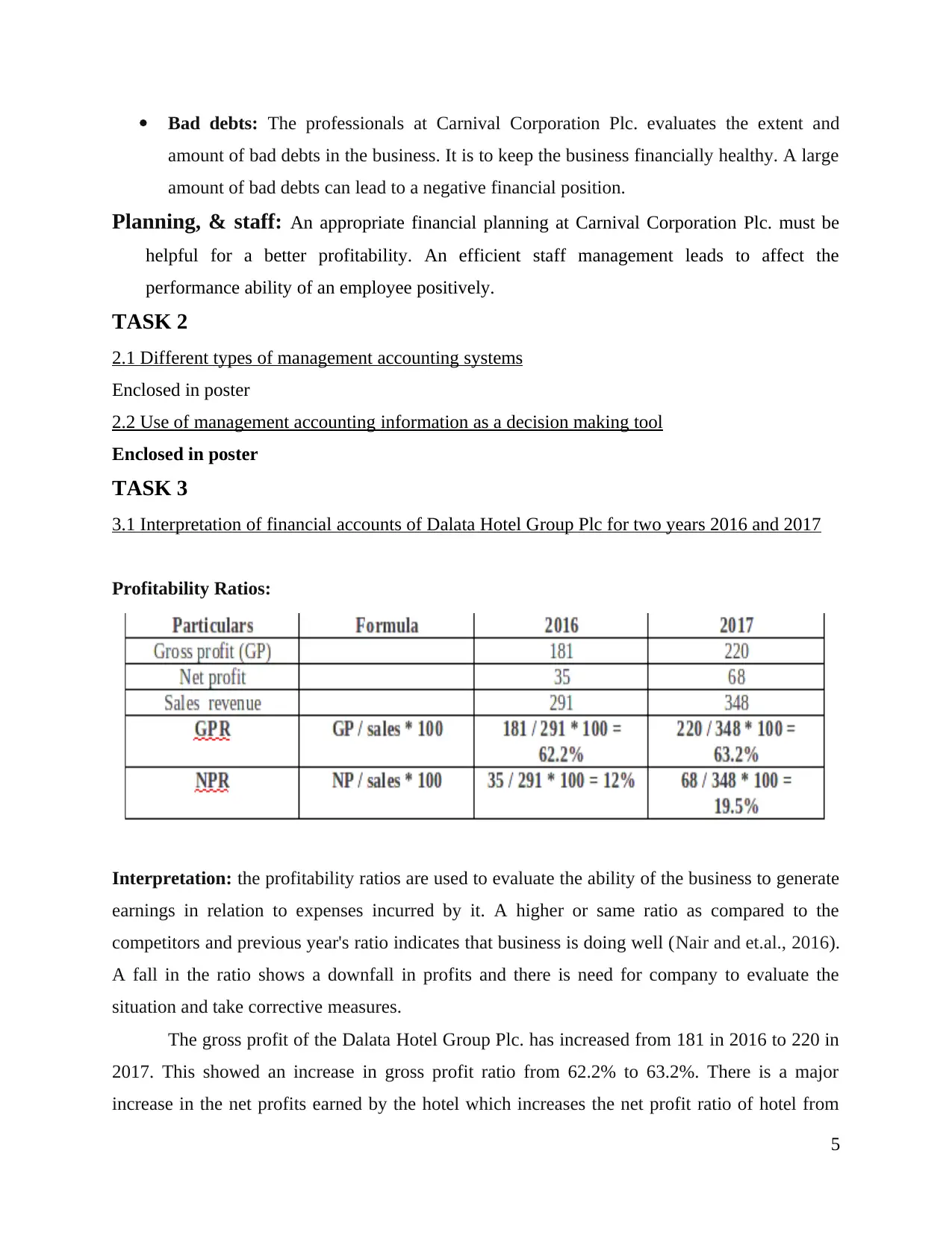
Bad debts: The professionals at Carnival Corporation Plc. evaluates the extent and
amount of bad debts in the business. It is to keep the business financially healthy. A large
amount of bad debts can lead to a negative financial position.
Planning, & staff: An appropriate financial planning at Carnival Corporation Plc. must be
helpful for a better profitability. An efficient staff management leads to affect the
performance ability of an employee positively.
TASK 2
2.1 Different types of management accounting systems
Enclosed in poster
2.2 Use of management accounting information as a decision making tool
Enclosed in poster
TASK 3
3.1 Interpretation of financial accounts of Dalata Hotel Group Plc for two years 2016 and 2017
Profitability Ratios:
Interpretation: the profitability ratios are used to evaluate the ability of the business to generate
earnings in relation to expenses incurred by it. A higher or same ratio as compared to the
competitors and previous year's ratio indicates that business is doing well (Nair and et.al., 2016).
A fall in the ratio shows a downfall in profits and there is need for company to evaluate the
situation and take corrective measures.
The gross profit of the Dalata Hotel Group Plc. has increased from 181 in 2016 to 220 in
2017. This showed an increase in gross profit ratio from 62.2% to 63.2%. There is a major
increase in the net profits earned by the hotel which increases the net profit ratio of hotel from
5
amount of bad debts in the business. It is to keep the business financially healthy. A large
amount of bad debts can lead to a negative financial position.
Planning, & staff: An appropriate financial planning at Carnival Corporation Plc. must be
helpful for a better profitability. An efficient staff management leads to affect the
performance ability of an employee positively.
TASK 2
2.1 Different types of management accounting systems
Enclosed in poster
2.2 Use of management accounting information as a decision making tool
Enclosed in poster
TASK 3
3.1 Interpretation of financial accounts of Dalata Hotel Group Plc for two years 2016 and 2017
Profitability Ratios:
Interpretation: the profitability ratios are used to evaluate the ability of the business to generate
earnings in relation to expenses incurred by it. A higher or same ratio as compared to the
competitors and previous year's ratio indicates that business is doing well (Nair and et.al., 2016).
A fall in the ratio shows a downfall in profits and there is need for company to evaluate the
situation and take corrective measures.
The gross profit of the Dalata Hotel Group Plc. has increased from 181 in 2016 to 220 in
2017. This showed an increase in gross profit ratio from 62.2% to 63.2%. There is a major
increase in the net profits earned by the hotel which increases the net profit ratio of hotel from
5
Paraphrase This Document
Need a fresh take? Get an instant paraphrase of this document with our AI Paraphraser
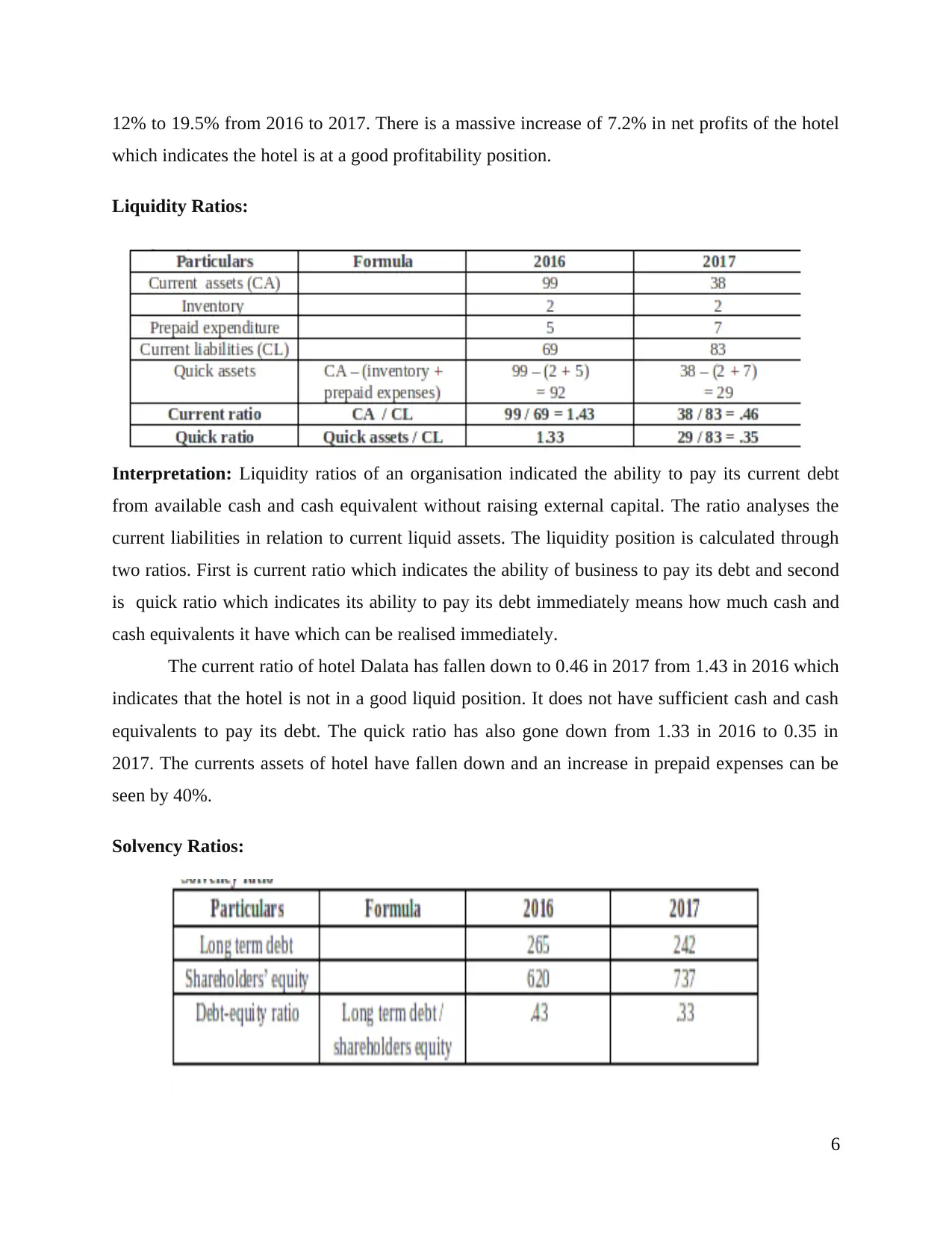
12% to 19.5% from 2016 to 2017. There is a massive increase of 7.2% in net profits of the hotel
which indicates the hotel is at a good profitability position.
Liquidity Ratios:
Interpretation: Liquidity ratios of an organisation indicated the ability to pay its current debt
from available cash and cash equivalent without raising external capital. The ratio analyses the
current liabilities in relation to current liquid assets. The liquidity position is calculated through
two ratios. First is current ratio which indicates the ability of business to pay its debt and second
is quick ratio which indicates its ability to pay its debt immediately means how much cash and
cash equivalents it have which can be realised immediately.
The current ratio of hotel Dalata has fallen down to 0.46 in 2017 from 1.43 in 2016 which
indicates that the hotel is not in a good liquid position. It does not have sufficient cash and cash
equivalents to pay its debt. The quick ratio has also gone down from 1.33 in 2016 to 0.35 in
2017. The currents assets of hotel have fallen down and an increase in prepaid expenses can be
seen by 40%.
Solvency Ratios:
6
which indicates the hotel is at a good profitability position.
Liquidity Ratios:
Interpretation: Liquidity ratios of an organisation indicated the ability to pay its current debt
from available cash and cash equivalent without raising external capital. The ratio analyses the
current liabilities in relation to current liquid assets. The liquidity position is calculated through
two ratios. First is current ratio which indicates the ability of business to pay its debt and second
is quick ratio which indicates its ability to pay its debt immediately means how much cash and
cash equivalents it have which can be realised immediately.
The current ratio of hotel Dalata has fallen down to 0.46 in 2017 from 1.43 in 2016 which
indicates that the hotel is not in a good liquid position. It does not have sufficient cash and cash
equivalents to pay its debt. The quick ratio has also gone down from 1.33 in 2016 to 0.35 in
2017. The currents assets of hotel have fallen down and an increase in prepaid expenses can be
seen by 40%.
Solvency Ratios:
6
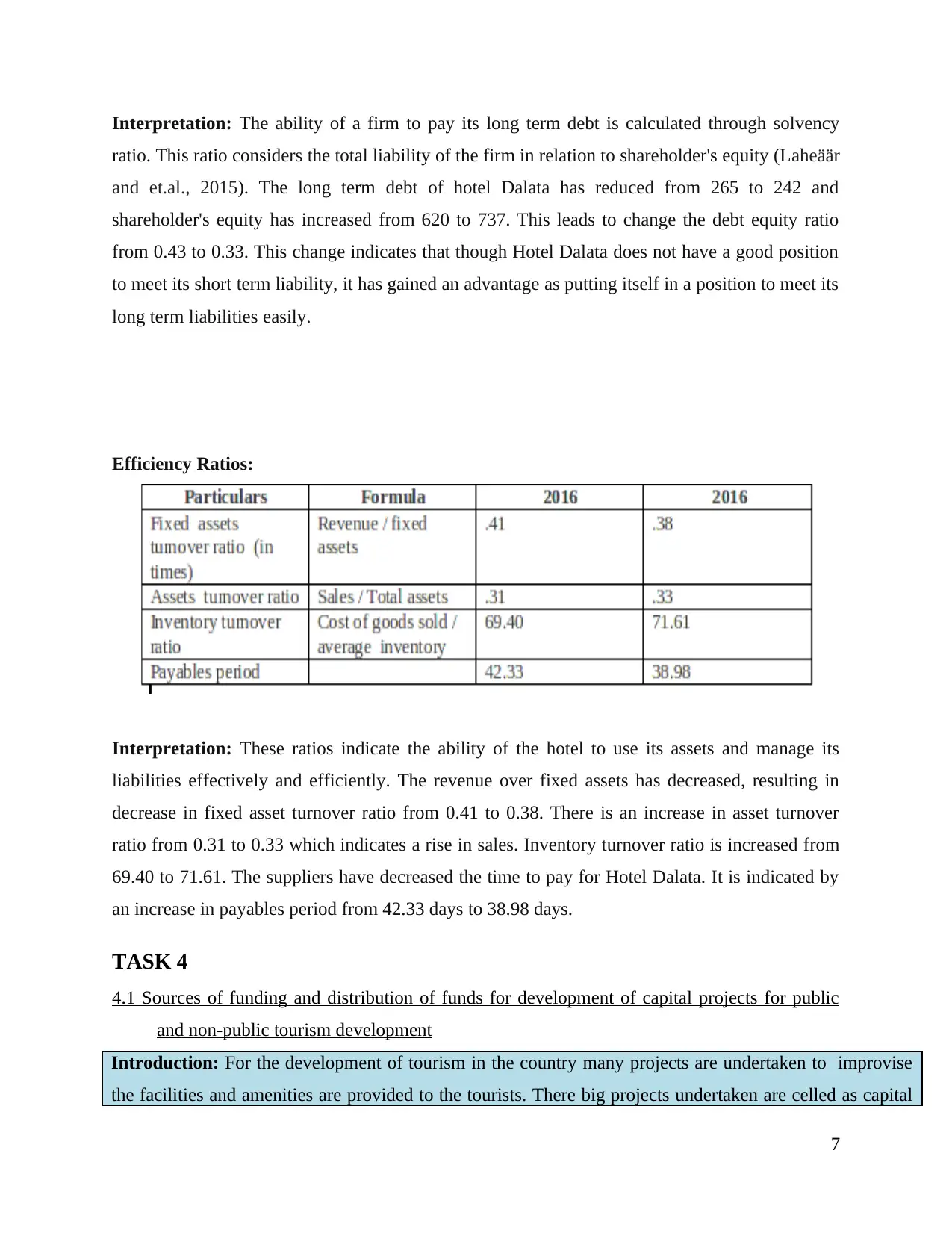
Interpretation: The ability of a firm to pay its long term debt is calculated through solvency
ratio. This ratio considers the total liability of the firm in relation to shareholder's equity (Laheäär
and et.al., 2015). The long term debt of hotel Dalata has reduced from 265 to 242 and
shareholder's equity has increased from 620 to 737. This leads to change the debt equity ratio
from 0.43 to 0.33. This change indicates that though Hotel Dalata does not have a good position
to meet its short term liability, it has gained an advantage as putting itself in a position to meet its
long term liabilities easily.
Efficiency Ratios:
Interpretation: These ratios indicate the ability of the hotel to use its assets and manage its
liabilities effectively and efficiently. The revenue over fixed assets has decreased, resulting in
decrease in fixed asset turnover ratio from 0.41 to 0.38. There is an increase in asset turnover
ratio from 0.31 to 0.33 which indicates a rise in sales. Inventory turnover ratio is increased from
69.40 to 71.61. The suppliers have decreased the time to pay for Hotel Dalata. It is indicated by
an increase in payables period from 42.33 days to 38.98 days.
TASK 4
4.1 Sources of funding and distribution of funds for development of capital projects for public
and non-public tourism development
Introduction: For the development of tourism in the country many projects are undertaken to improvise
the facilities and amenities are provided to the tourists. There big projects undertaken are celled as capital
7
ratio. This ratio considers the total liability of the firm in relation to shareholder's equity (Laheäär
and et.al., 2015). The long term debt of hotel Dalata has reduced from 265 to 242 and
shareholder's equity has increased from 620 to 737. This leads to change the debt equity ratio
from 0.43 to 0.33. This change indicates that though Hotel Dalata does not have a good position
to meet its short term liability, it has gained an advantage as putting itself in a position to meet its
long term liabilities easily.
Efficiency Ratios:
Interpretation: These ratios indicate the ability of the hotel to use its assets and manage its
liabilities effectively and efficiently. The revenue over fixed assets has decreased, resulting in
decrease in fixed asset turnover ratio from 0.41 to 0.38. There is an increase in asset turnover
ratio from 0.31 to 0.33 which indicates a rise in sales. Inventory turnover ratio is increased from
69.40 to 71.61. The suppliers have decreased the time to pay for Hotel Dalata. It is indicated by
an increase in payables period from 42.33 days to 38.98 days.
TASK 4
4.1 Sources of funding and distribution of funds for development of capital projects for public
and non-public tourism development
Introduction: For the development of tourism in the country many projects are undertaken to improvise
the facilities and amenities are provided to the tourists. There big projects undertaken are celled as capital
7
⊘ This is a preview!⊘
Do you want full access?
Subscribe today to unlock all pages.

Trusted by 1+ million students worldwide
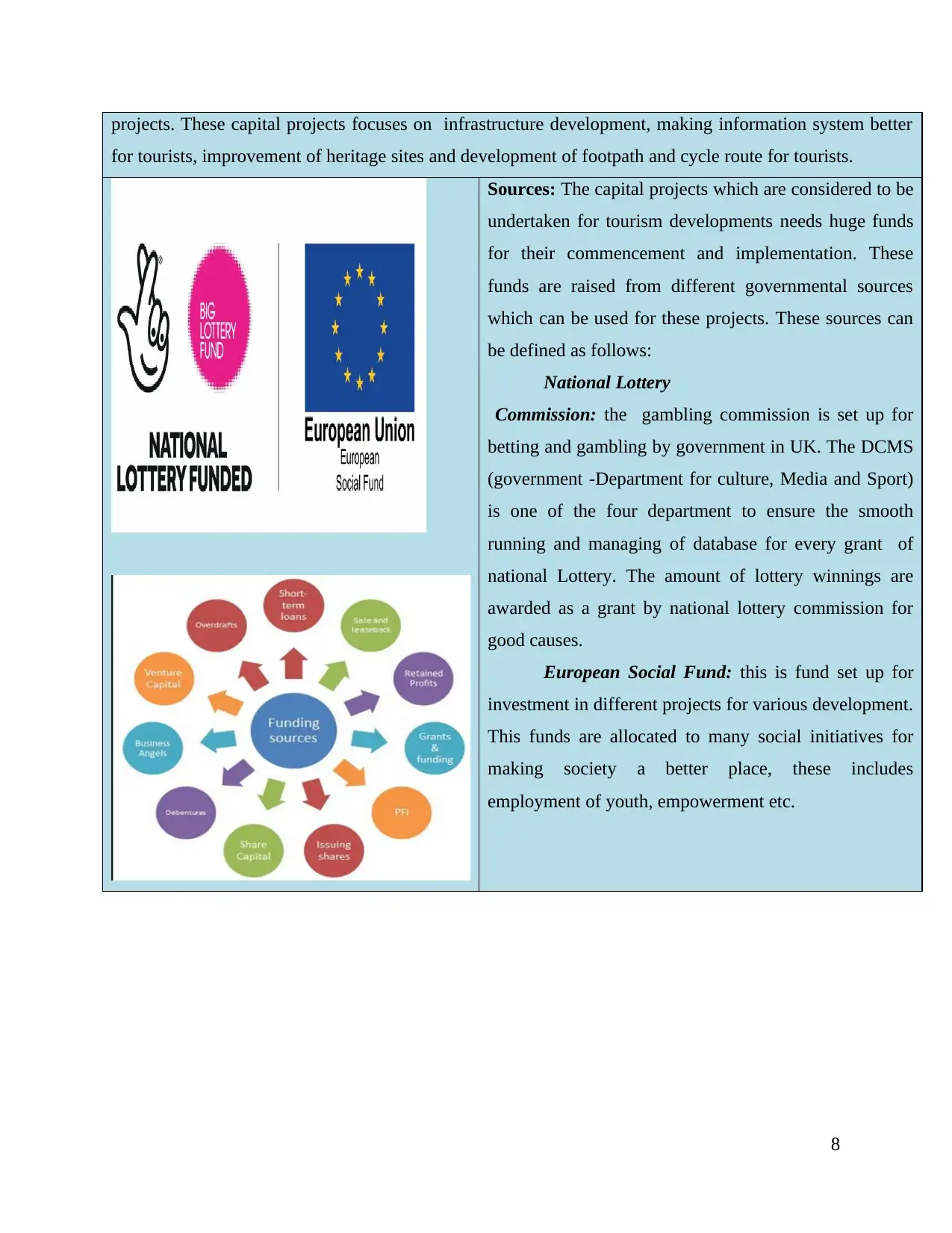
projects. These capital projects focuses on infrastructure development, making information system better
for tourists, improvement of heritage sites and development of footpath and cycle route for tourists.
Sources: The capital projects which are considered to be
undertaken for tourism developments needs huge funds
for their commencement and implementation. These
funds are raised from different governmental sources
which can be used for these projects. These sources can
be defined as follows:
National Lottery
Commission: the gambling commission is set up for
betting and gambling by government in UK. The DCMS
(government -Department for culture, Media and Sport)
is one of the four department to ensure the smooth
running and managing of database for every grant of
national Lottery. The amount of lottery winnings are
awarded as a grant by national lottery commission for
good causes.
European Social Fund: this is fund set up for
investment in different projects for various development.
This funds are allocated to many social initiatives for
making society a better place, these includes
employment of youth, empowerment etc.
8
for tourists, improvement of heritage sites and development of footpath and cycle route for tourists.
Sources: The capital projects which are considered to be
undertaken for tourism developments needs huge funds
for their commencement and implementation. These
funds are raised from different governmental sources
which can be used for these projects. These sources can
be defined as follows:
National Lottery
Commission: the gambling commission is set up for
betting and gambling by government in UK. The DCMS
(government -Department for culture, Media and Sport)
is one of the four department to ensure the smooth
running and managing of database for every grant of
national Lottery. The amount of lottery winnings are
awarded as a grant by national lottery commission for
good causes.
European Social Fund: this is fund set up for
investment in different projects for various development.
This funds are allocated to many social initiatives for
making society a better place, these includes
employment of youth, empowerment etc.
8
Paraphrase This Document
Need a fresh take? Get an instant paraphrase of this document with our AI Paraphraser
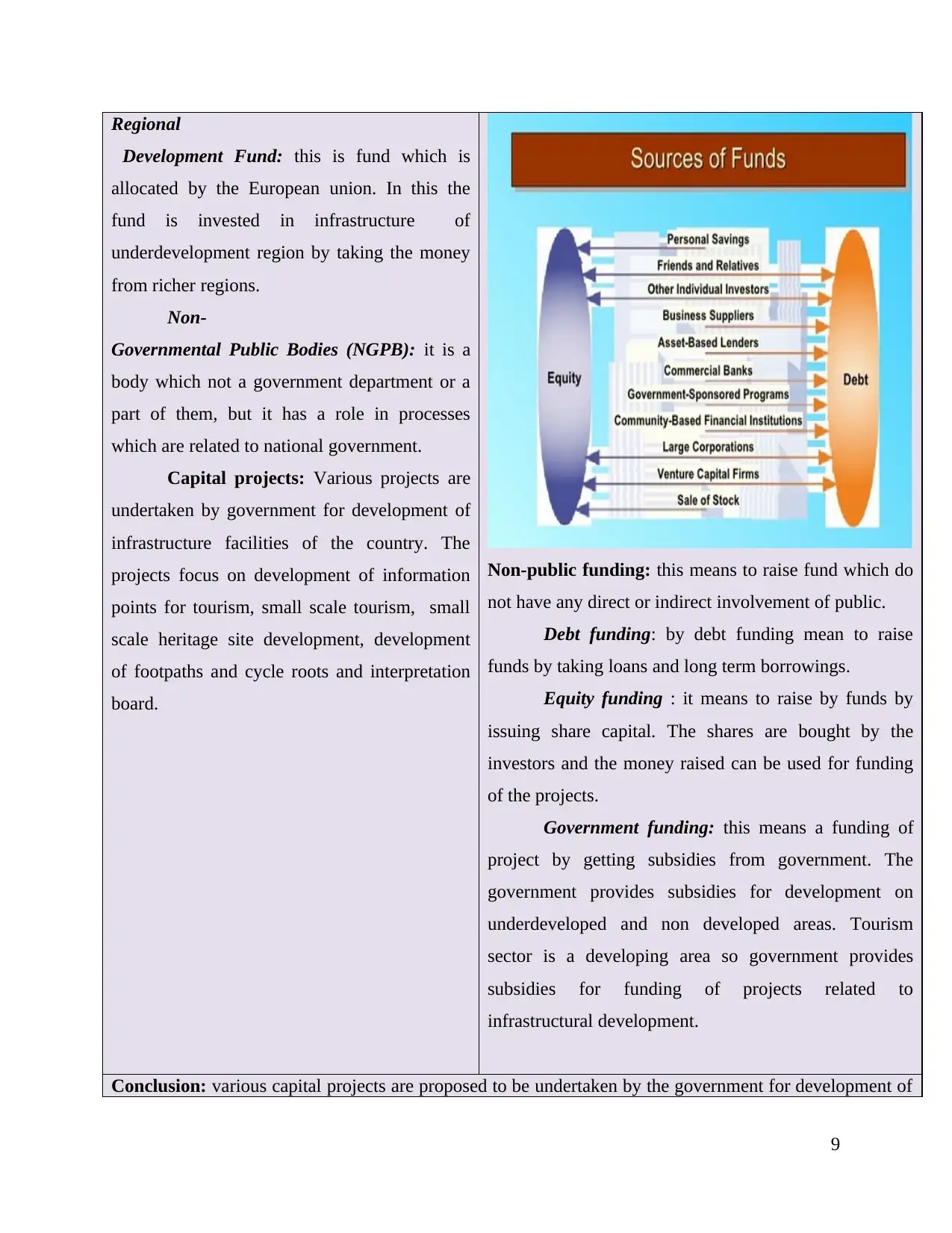
Regional
Development Fund: this is fund which is
allocated by the European union. In this the
fund is invested in infrastructure of
underdevelopment region by taking the money
from richer regions.
Non-
Governmental Public Bodies (NGPB): it is a
body which not a government department or a
part of them, but it has a role in processes
which are related to national government.
Capital projects: Various projects are
undertaken by government for development of
infrastructure facilities of the country. The
projects focus on development of information
points for tourism, small scale tourism, small
scale heritage site development, development
of footpaths and cycle roots and interpretation
board.
Non-public funding: this means to raise fund which do
not have any direct or indirect involvement of public.
Debt funding: by debt funding mean to raise
funds by taking loans and long term borrowings.
Equity funding : it means to raise by funds by
issuing share capital. The shares are bought by the
investors and the money raised can be used for funding
of the projects.
Government funding: this means a funding of
project by getting subsidies from government. The
government provides subsidies for development on
underdeveloped and non developed areas. Tourism
sector is a developing area so government provides
subsidies for funding of projects related to
infrastructural development.
Conclusion: various capital projects are proposed to be undertaken by the government for development of
9
Development Fund: this is fund which is
allocated by the European union. In this the
fund is invested in infrastructure of
underdevelopment region by taking the money
from richer regions.
Non-
Governmental Public Bodies (NGPB): it is a
body which not a government department or a
part of them, but it has a role in processes
which are related to national government.
Capital projects: Various projects are
undertaken by government for development of
infrastructure facilities of the country. The
projects focus on development of information
points for tourism, small scale tourism, small
scale heritage site development, development
of footpaths and cycle roots and interpretation
board.
Non-public funding: this means to raise fund which do
not have any direct or indirect involvement of public.
Debt funding: by debt funding mean to raise
funds by taking loans and long term borrowings.
Equity funding : it means to raise by funds by
issuing share capital. The shares are bought by the
investors and the money raised can be used for funding
of the projects.
Government funding: this means a funding of
project by getting subsidies from government. The
government provides subsidies for development on
underdeveloped and non developed areas. Tourism
sector is a developing area so government provides
subsidies for funding of projects related to
infrastructural development.
Conclusion: various capital projects are proposed to be undertaken by the government for development of
9
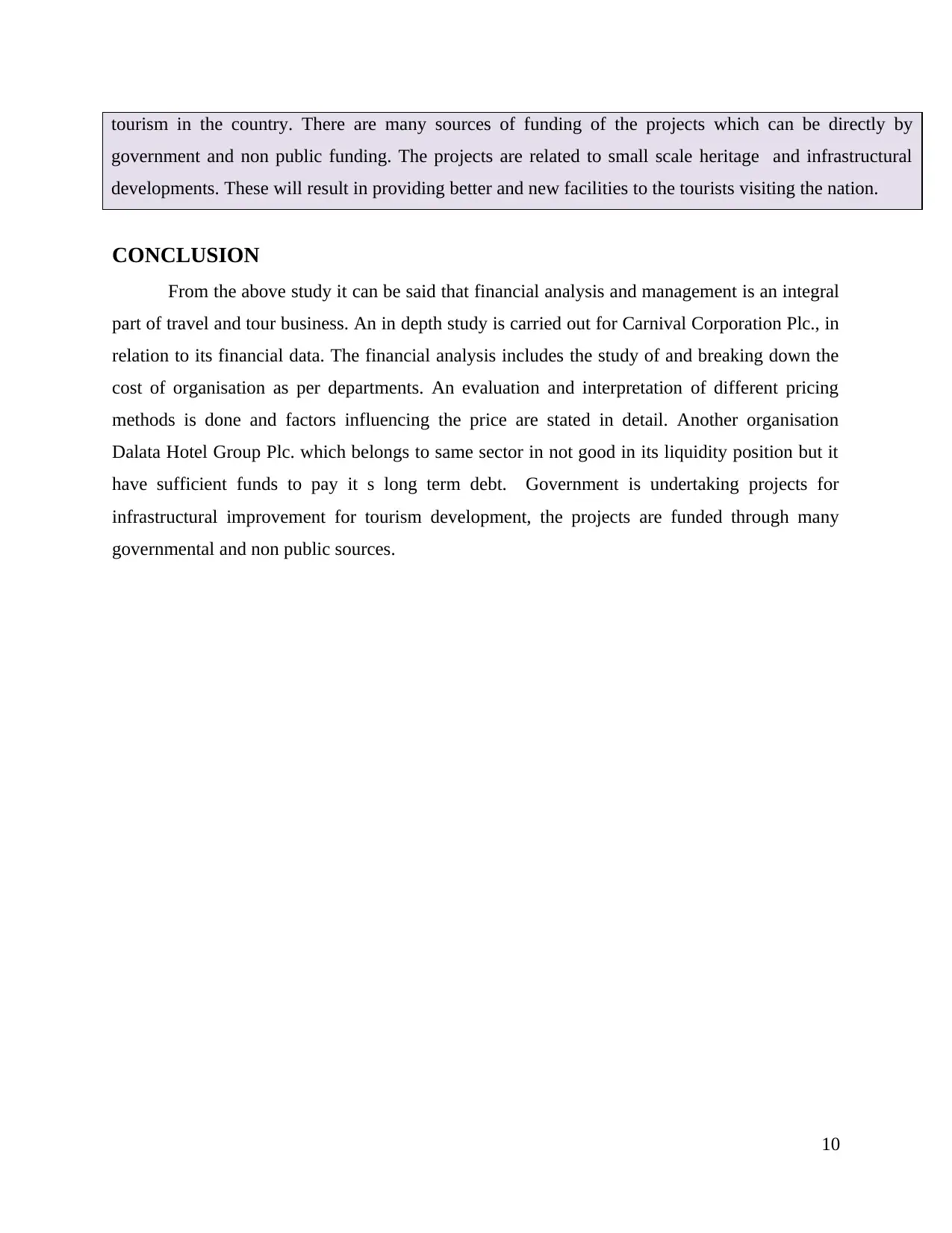
tourism in the country. There are many sources of funding of the projects which can be directly by
government and non public funding. The projects are related to small scale heritage and infrastructural
developments. These will result in providing better and new facilities to the tourists visiting the nation.
CONCLUSION
From the above study it can be said that financial analysis and management is an integral
part of travel and tour business. An in depth study is carried out for Carnival Corporation Plc., in
relation to its financial data. The financial analysis includes the study of and breaking down the
cost of organisation as per departments. An evaluation and interpretation of different pricing
methods is done and factors influencing the price are stated in detail. Another organisation
Dalata Hotel Group Plc. which belongs to same sector in not good in its liquidity position but it
have sufficient funds to pay it s long term debt. Government is undertaking projects for
infrastructural improvement for tourism development, the projects are funded through many
governmental and non public sources.
10
government and non public funding. The projects are related to small scale heritage and infrastructural
developments. These will result in providing better and new facilities to the tourists visiting the nation.
CONCLUSION
From the above study it can be said that financial analysis and management is an integral
part of travel and tour business. An in depth study is carried out for Carnival Corporation Plc., in
relation to its financial data. The financial analysis includes the study of and breaking down the
cost of organisation as per departments. An evaluation and interpretation of different pricing
methods is done and factors influencing the price are stated in detail. Another organisation
Dalata Hotel Group Plc. which belongs to same sector in not good in its liquidity position but it
have sufficient funds to pay it s long term debt. Government is undertaking projects for
infrastructural improvement for tourism development, the projects are funded through many
governmental and non public sources.
10
⊘ This is a preview!⊘
Do you want full access?
Subscribe today to unlock all pages.

Trusted by 1+ million students worldwide
1 out of 15
Related Documents
Your All-in-One AI-Powered Toolkit for Academic Success.
+13062052269
info@desklib.com
Available 24*7 on WhatsApp / Email
![[object Object]](/_next/static/media/star-bottom.7253800d.svg)
Unlock your academic potential
Copyright © 2020–2025 A2Z Services. All Rights Reserved. Developed and managed by ZUCOL.





